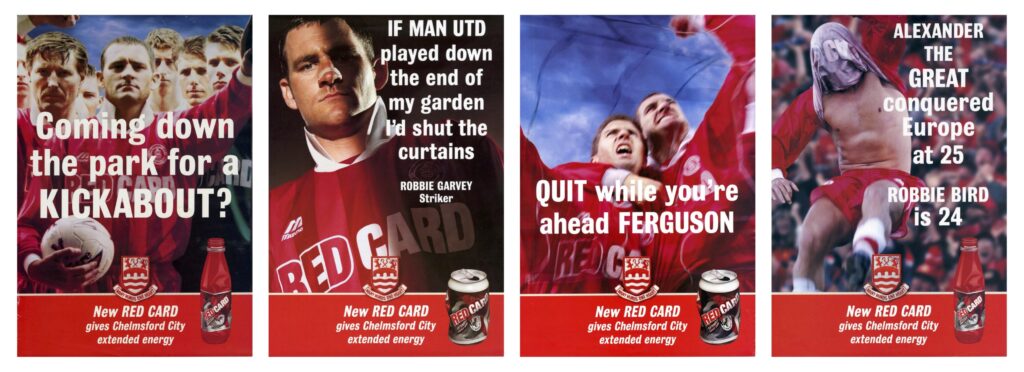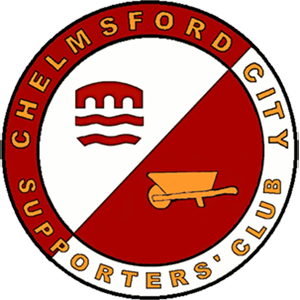
Jon Read tells me that I once said, “Everyone has a book in them!” Well as JR’s been published twice, he must have penned one for me too so I’m off the hook! If I had been so able to follow his example, the events of 1996 would be one of the richest sources of material, both personally and in my association with Chelmsford City Football Club …
The year started with City, managed by the silver fox Joe Sullivan, sitting comfortably in the Southern League Premier Division. I was Club Secretary at the time, a voluntary position that fitted in nicely with part-time jobs at the Black Horse pub in the morning and the Odeon Cinema three evenings a week … #livingthedream!
Joe would resign towards the end of January with Robbie Garvey and Paul Watts taking on the role of joint player-managers. Although they had no real experience it was a popular choice with the fans and a 6-1 Monday night thumping of Gravesend in their first game in charge did them no harm at all. Results varied thereafter but the campaign concluded with two wins and a respectable mid-table finish. Sometime towards the end of that season I took a couple of phone calls in the office, pivotal to what followed. The first was from somebody introducing himself as “Gary Bellamy” and I got a mental image of a Panini sticker with a moustached-player in a gold shirt. “The centre half who played for Wolves?” I asked. I think he was flattered but he was also modest enough to admit that more recently he was the “centre-half who played for Chesterfield and Orient.”
Gary had moved to the area and was looking for opportunities to get involved in community coaching, at the time relatively unheard of at non-league level. He came down to a midweek game soon after, met the board and would of course go on to play for and manage City, as well as set up a programme of coaching sessions with local schools. I assisted him a few times … well somebody had to put out the cones and balls … and it was great to see the kids listen and learn from Gary while enjoying a kickabout. The second phone call, and I’m pretty sure it was within a few days, was from a marketing company working on a new campaign. They didn’t reveal the client or the product but did say one option being considered was using a ‘grass roots’ football team as the central theme. I put some match programmes, memorabilia and general information in an envelope and posted it off to them, probably thinking that would be that. It’s worth remembering that 1996 was the infancy of the digital age, Tim Berners-Lee had only created the first ever website a few years earlier so there was no going on-line. If you wanted to find out information about someone or something you still had to read it in a book or actually speak to them … imagine that, kids!
Anyway, the marketing company did come back to us and met chairman Trevor Wright and members of the board, revealing that the client was Chelmsford-based Britvic and they were launching a new extended-energy drink, Red Card. When the deal was agreed in the Summer it was one of the biggest in non-league football, helping allay some of the immediate financial concerns and raising the profile of the Club. Around the same time decisions had been taken about the playing side with Roy ‘Red Card’ McDonough appointed as First Team player-manager.
We know that what followed was not much short of a disaster but going into the new season anyone connected to Chelmsford City had every reason to be optimistic … we had some money in the bank; there was a sense of the Club being led by the supporters, that it was in safe hands; we had a manager with a proven track record (Roy had taken Colchester United back to the Football League as recently as 1992) and we were about to be unleashed on an unsuspecting nation in a major promotional campaign. What could possibly go wrong?
Well for one thing, as part of the sponsorship deal, the team strip would be changing from the beloved claret to red, tying in with the branding of the new product. As I’ve gone on to have a career in marketing, I’d have to say at the time it made perfect sense. The kit was designed by Wayne Hemmingway, co-founder of the influential ‘Red or Dead’ label, and produced by the supplier Mizuno. Setting aside the break with tradition it was a very smart, unfussy strip although it doesn’t seem to have made a great impression on its creator. In preparing for this article, I have swapped some emails with the man himself, and I would like to thank Mr Hemmingway for being kind enough to take the time to correspond but he didn’t recall how he got involved. At the time of writing, his colleagues are looking further into the archives, so maybe more information will come through.
So around the start of the 1996-97 season City players, resplendent in the all-red strip, stepped on to the hallowed turf of the original Wembley Stadium for the publicity photoshoot. Well, almost. For much of the journey to Wembley the coach party had been entertained by centre-half Paul Roberts. He was taking the ‘knowledge’ at the time and his comedy London cabby routine was pretty good. Roberts had joined the Club with McDonough and never really won over the majority of City fans. He was a decent player though, with a few hundred Football League appearances in his career but I notice that his Wikipedia page doesn’t reference the brief spell at Chelmsford!
I went along that day and on arrival we were all told by security guards, and some embarrassingly small white signs, DO NOT GO ON THE PITCH. Naturally everyone, myself included, ignored that and took advantage to say they had set foot on the famous grass. When a football ‘accidently’ found its way near the centre of the pitch, there were plenty of volunteers to go on and kick it back, if memory serves Ray Taylor won the race. It was a great experience and I spent much of the morning with dear Don Walker. We found an open café area somewhere behind the stands and had a cuppa, Don remarking it was “great to see City at Wembley!”
I didn’t make the journey back on the team coach later that day. Trevor Wright was asked to do a few interviews over the phone with some regional press and I went with him to the marketing company offices in Central London. Sadly, the ad agency, HCCL, ceased trading many years ago so they can’t help with any background but they did have a reputation in the industry, creating the infamous ‘Orange Man / You Know When You’ve Been Tangoed’ campaign, which was also a Britvic product.
Wayne Hemmingway did some interviews that afternoon too. Several of the journalists were sceptical about his passionate case that the strip was a ‘new concept’ but as a no-nonsense Northerner he stuck to his guns to win them over. That evening, the Carlton (Thames) TV News ran a feature on the promotional launch and for a while this could be found on You Tube. Almost as if somebody is trying to erase, or should that be rescind, the memory of Red Card, the video has been taken down now. I believe a City supporter had a VHS copy of the news report and had offered to convert it to digital format so hopefully it will resurface one day.
I recently contacted the press office at Britvic’s HQ, now in Hertfordshire, and they kindly provided some more information from their archives. The budget for the marketing campaign was an impressive £3m … I can assure you City didn’t get that much! The official summary of the marketing strategy was:
- Red Card is marketed as a no-nonsense, no-glamour energy drink, and is primarily aimed at young males.
- Red Card’s marketing values include: mud not lycra, British not global, and effort not talent.
Red Card sponsored Chelmsford City Football Club during the 1996/97 and 1997/98 seasons, reinforcing its image as an urban “real life” drink.
In the weeks and months that followed, posters and advertisements could be seen on billboards, bus shelters and in national newspapers. As well as the standard message “Red Card: Keeps You Going Until You’re Sent Off!” many had sub-themes and more than one of these poked fun at the biggest club in the land, Manchester United. It became apparent that not everyone in that part of the world took kindly to this when I opened a letter in the office one day and a couple of razor blades were concealed under the flap – luckily I hadn’t touched that part of the envelope. The accompanying letter included some pretty graphic language and was signed on behalf of a group of United supporters. In a strange quirk of fate, Gary Bellamy, by now the joint player-manager (with Colin Norman) and also the Club’s general manager, was having a routine meeting in the Boardroom with the Essex Constabulary so I carefully passed the envelope to the police officer and left counting my blessings and my fingers!
MUFC themselves also displayed a serious lack of humour as they made a complaint to the Advertising Standards Agency about one ad in particular that said, “If you can smell fear, Manchester United must reek!” Thankfully, common sense prevailed and in February 1997 the complaint was rejected by the ASA with the additional comment, “The ad was clearly intended to be funny.” (So was Mike Phelan popping a balloon near Alex Ferguson – Google it!)
City’s bubble would also burst and despite everyone’s best efforts we were relegated at the end of the 1996-97 season. Many of the experienced players left the Club but far worse was to follow with the loss of our beloved New Writtle Street, the financial situation finally proving too much to overcome. Home games were played at Maldon then Billericay and we would spend a few seasons trying to overcome the League administrators and the opposition to get out of the Southern Division.
It was very welcome when Britvic generously renewed the sponsorship for a second year, tweaking the themes to match our (even) lower status but the campaign and the product itself didn’t have the energy it promised. Red Card would be withdrawn from sale around a year later.
The 96-97 season was a watershed time for me too. Gary Bellamy and I enjoyed the ‘staff Christmas lunch’ at the Pizza Hut, Chelmer Village but changes of work meant I spent more time away from the Club. Although continuing as Secretary for a while, I missed quite a few games in the second half of the season. In fact, over the next two years, prior to moving up to Blackpool, I probably watched City less than at any time since attending my first League game in 1979. So, 25 years on, how do we reflect on the events of 1996? On the field … a scruffy goal somewhere, a fortunate win and maybe the team’s form would have turned around and Roy McDonough’s time as manager would have been very different. Off the field … I don’t think any club at our level would have turned down the opportunity that Britvic presented to us with the Red Card sponsorship, even if it did mean changing the playing strip.
In the end perhaps all we can say is, it was just “Typical Chelmsford City!”

